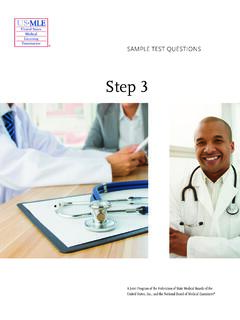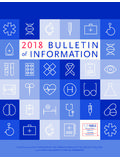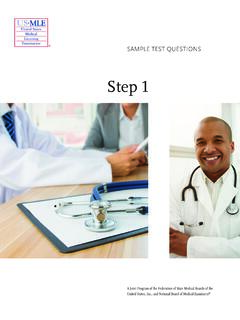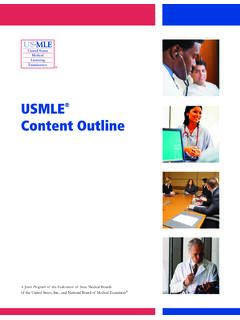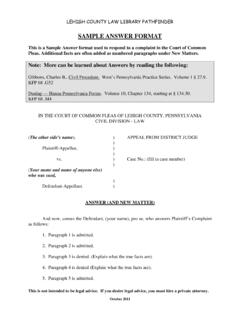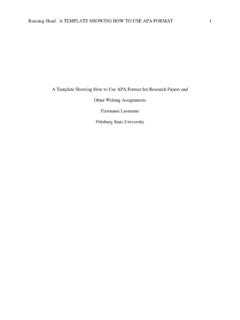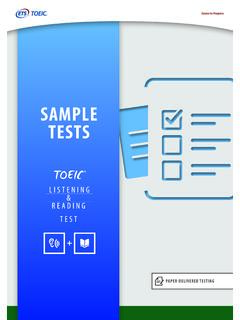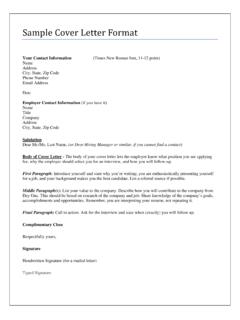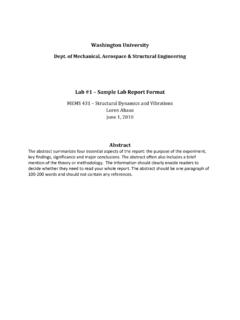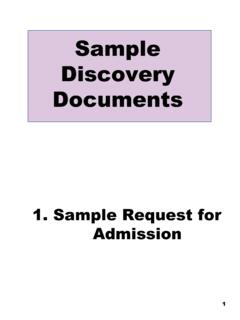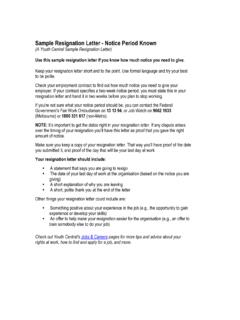Transcription of Step 2 Clinical Knowledge (CK) - USMLE
1 SAMPLE TEST QUESTIONS. step 2 Clinical Knowledge (CK). A Joint Program of the Federation of State Medical Boards of the United States, Inc., and National Board of Medical Examiners . This booklet was updated March 2021. For Public Release Copyright 2021 by the Federation of State Medical Boards of the United States, Inc. (FSMB), and the National Board of Medical Examiners (NBME ). All rights reserved. Printed in the United States of America. The United States Medical Licensing Examination . ( USMLE ) is a joint program of the FSMB and NBME. 1. CONTENTS. USMLE step 2 CK Test Question Formats .. 3. Introduction to USMLE step 2 CK Sample Test Questions .. 9. USMLE Laboratory Values .. 10. USMLE step 2 CK Sample Test Questions .. 13. Block 1, Items 1 40 .. 13. Block 2, Items 41 80 .. 27. Block 3, Items 81 120.
2 42. Answer Form for USMLE step 2 CK Sample Test Questions .. 57. Answer Key for USMLE step 2 CK Sample Test Questions .. 58. 2. USMLE step 2 CK TEST QUESTION FORMATS. The following are strategies for answering one-best-answer items: Read each question carefully. It is important to understand what is being asked. Try to generate an answer and then look for it in the response option list. Alternatively, read each response option carefully, eliminating those that are clearly incorrect. Of the remaining response options, select the one that is most correct. If unsure about an answer, it is better to guess since unanswered questions are automatically counted as wrong answers . Patient Scenario Formats Patient scenarios for any Single Item or Sequential Item Set may be provided in either Vignette (paragraph) format , or in Chart/Tabular format .
3 Questions written in Chart/Tabular format will contain relevant patient information in list form, organized in clearly marked sections for ease of review. Familiar medical abbreviations may be used within Chart/Tabular format questions. Single-Item Questions A single patient-centered vignette is associated with one question followed by four or more response options. The response options are lettered (ie, A, B, C, D, E). A portion of the questions involves interpretation of graphic or pictorial materials. You are required to select the best answer to the question. Other options may be partially correct, but there is only ONE BEST answer. This is the traditional, most frequently used multiple-choice question format on the examination. Example Question 1. A 32-year-old woman with type 1 diabetes mellitus has had progressive renal failure over the past 2 years.
4 She has not yet started dialysis. Examination shows no abnormalities. Her hemoglobin concentration is 9 g/dL, hematocrit is 28%, and mean corpuscular volume is 94 m3. A blood smear shows normochromic, normocytic cells. Which of the following is the most likely cause? (A) Acute blood loss (F) Microangiopathic hemolysis (B) Chronic lymphocytic leukemia (G) Polycythemia vera (C) Erythrocyte enzyme deficiency (H) Sickle cell disease (D) Erythropoietin deficiency (I) Sideroblastic anemia (E) Immunohemolysis (J) -Thalassemia trait (Answer: D). 3. Example Question 2. Patient Information Age: 18 years Gender: F, self-identified Ethnicity: unspecified Site of Care: emergency department History Chief Complaint: "My roommate took a lot of pills and said she wanted to die.". History of Present Illness: patient brought by ambulance 2 hours after a suspected acetaminophen overdose roommate had returned to their dorm and found the patient distraught; patient was holding an empty bottle of acetaminophen and said, "I just want to die.
5 ". roommate estimates patient consumed 20 to 30 tablets of 500-mg acetaminophen Past Medical History: generalized anxiety disorder major depressive disorder Medications: citalopram Allergies: no known drug allergies Family History: noncontributory Psychosocial History: college freshman; parents live 8 hours away Physical Examination Temp Pulse Resp BP O2 Sat Ht Wt BMI. C 89/min 16/min 108/59 mm Hg 99% 170 cm 63 kg 22 kg/m2. ( F) on RA (5 ft 7 in) (140 lb). Appearance: awake and alert but distraught and fearful; patient says, "This was totally stupid.". Pulmonary: clear lung fields Cardiac: regular rhythm; S1 and S2, with an early systolic murmur Abdominal: soft and nontender; liver and spleen cannot be palpated Neurologic: no abnormalities; fully oriented Question: In addition to obtaining serum acetaminophen concentration, which of the following is the most appropriate next step in management?
6 (A) Administer N-acetylcysteine (B) Arrange hemodialysis (C) Gastric lavage (D) Initiate sodium bicarbonate infusion (Answer: A). 4. Sequential Item Sets A single patient-centered vignette may be associated with two or three consecutive questions about the information presented. Each question is associated with the initial patient vignette but is testing a different point. You are required to select the ONE BEST answer to each question. These questions are designed to be answered in sequential order. You must click Proceed to Next Item to view the next item in the set; once you click on this button, the next question will be displayed, and you will not be able to change the answer to the previous question. Example Sequential Question A 35-year-old woman is brought to the emergency department because of worsening pain and swelling of her right knee for the past 2 days.
7 She has been taking acetaminophen for the knee pain during the past 2 days, but the pain is worse today. She has not had any trauma to the knee or any previous problems with her joints. She is otherwise healthy and she currently takes an oral contraceptive. She is sexually active and has a 10-year-old son who lives with her. She is a receptionist at a local hotel and she tells you she must stand often while working. She is 160 cm (5 ft 3 in) tall and weighs 52 kg (115 lb); BMI is 20 kg/m2. Temperature is C ( F). The right knee is erythematous, swollen, and tender;. there is pain on movement. No other joints are affected. X-ray of the knee shows an effusion but no structural abnormalities of the joint. Which of the following is the most appropriate next step in diagnosis? (A) Arthrocentesis of the knee (B) Blood cultures (C) Complete blood count (D) MRI of the knee (E) Urine cultures (Answer: A).
8 Arthrocentesis is done. The synovial fluid is cloudy. Gram stain is negative. Analysis of the synovial fluid shows a leukocyte count of 120,000/mm3 and 90% neutrophils. Which of the following is the most appropriate additional test on the synovial fluid? (A) Culture for bacteria (B) Glucose measurement (C) Polarized light microscopy (D) Protein level (Answer: A). 5. Abstract Set format The abstract item format includes a summary of an experiment or Clinical investigation presented in a manner commonly encountered by a physician, eg, as an abstract that accompanies a research report in a medical journal. Examinees must interpret the abstract in order to answer questions on various topics, including Decisions about care of an individual patient Biostatistics/epidemiology Pharmacology/therapeutics Use of diagnostic studies Example Abstract Set Question In children with type 1 diabetes mellitus, what factors are associated with increased risk for microalbuminuria and macroalbuminuria?
9 Methods Design: Inception cohort followed for a mean of years. Setting: St. Bartholomew's Oxford Diabetes Register, Oxford, England, UK. Patients: 527 children < 16 years of age (mean age 9 years) who were diagnosed with type 1 diabetes mellitus and included in the Diabetes Register from 1986 to 1997 (90% follow-up). Prognostic factors: Mean glycated hemoglobin concentration (HbA1c), female sex, mean blood pressure, history of smoking, and age at diagnosis. Outcomes: Microalbuminuria (albumin-to-creatinine ratio to 35 mg/mmol in boys and to 47 mg/mmol in girls, in 2 annual, consecutive, early morning urine samples), and macroalbuminuria (albumin-to-creatinine ratio > 35 mg/mmol in boys and > 47 mg/mmol in girls). Main results 135 patients (26%) developed microalbuminuria, with a cumulative prevalence of (95% CI 21 to 30) after 10 years and 51% (CI 41 to 61) after 19 years.
10 Of the 135 patients with microalbuminuria, there was a cumulative prevalence of regression to the normoalbuminuric range of 52% (CI 42 to 62) after years from the onset of microalbuminuria. 18. patients (3%) developed macroalbuminuria, with a cumulative prevalence of 14% (CI 13 to 15) after years from onset of microalbuminuria. HbA1c and female sex were associated with increased risk for microalbuminuria (Table). HbA1c and persistent and intermittent microalbuminuria were associated with increased risk for macroalbuminuria (Table). Conclusions In children with type 1 diabetes mellitus, poor glycemic control and female sex were associated with development of microalbuminuria. About half of patients with microalbuminuria regressed to normoalbuminuria. Poor glycemic control and persistent or intermittent microalbuminuria were associated with development of macroalbuminuria.
